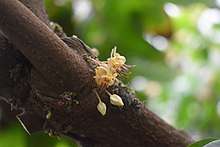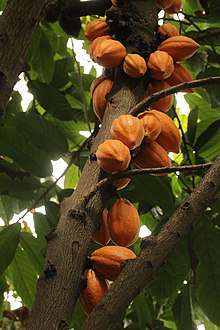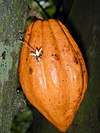Raw chocolate
Raw chocolate is chocolate produced primarily from unroasted cocoa beans. Dairy products are often not added to raw chocolate and alternative or alcohol sugars, such as coconut sugar, coconut nectar, xylitol, agave nectar, maple syrup, and stevia, are used.[1] Raw chocolate is naturally gluten-free and generally considered vegan.


Cacao tree
The cacao tree, also known as Theobroma cacao, is where chocolate is first formed[2]. The chocolate that is harvested from this tree is called the Cacao bean or Cocoa bean. These beans are seeds found inside the fruit of the tree, known as pods. The pods have a hard shell that is brightly colored and grows in clusters on the branches of the tree. Pods start as clusters of non-scented, small white flowers; this is a type of flowering cycle is called cocoa Cauliflory. These flowers are grown on the cushioning of the tree, or aged branches.

It takes around 4 to 5 months for the cacao pods to fully develop into a 20 cm long pod. After several weeks, they ripen into an orange and red coloring. The cacao seeds themselves are small, brown, pebble like beans that are produced inside the cacao pods. On average 30 to 50 seeds are in each pod, and there are 20 to 30 pods produced a year. This plant grows in lowland tropical rain forest environments where shade, humidity, and regular rainfall occur. Places that fit these conditions are for the most part located between the two tropics and spread around the world (West and East Africa, Central and South America, the Caribbean islands, Indonesia, and Pacific islands such as Fiji and Vanuatu)[3][4]. These trees have a life span around 100 years.[5]

Harvesting
The harvesting of cacao pods consists of removing ripe pods from the trunk of the cacao tree to extract the beans from inside. The cacao pods are harvested manually once or twice a year. The harvesters will get the pods down by using a blade.[6] Pods high up in the tree however, require a special type of tool. This tool consist of a long pole with a handle on one end, and a hook on the other.[7] They will push, pull, or twist the tool depending on the positioning of the fruit, to cut the pods down without damaging the branches.
It is important not to damage the flower cushioning of the tree; this is what produces flowering for future harvests. Harvesters recommend to open the cacao pod with a wooden club, so the beans inside are not damaged. After the extraction, the beans will begin a fermentation process, and set to dry before reaching the market.[8]
Processing[7]
After the fermentation process, described in harvesting, the beans are cleaned and the shells are removed from the nibs, a process known as Winnowing. The nibs then go through an alkalisation process, and are then milled to create cocoa liquor. Mechanically pressing the cocoa liquor, Cocoa butter is extracted which leaves "cocoa presscake"[9] ; the cocoa butter makes chocolate and the presscake is used to create cocoa powder.[10] The chocolate then undergoes a series of refining processes such as conching and tempering.[10] Finally it is moulded and packaged.
Popularity
Raw chocolate represents a fast-growing segment of the chocolate industry. Raw chocolate has been on the rise in popularity according to the Global Organic Chocolate Market.[11] Starting back in the early 2010s, it is predicted that the global organic chocolate market will rise 2.38%.[12] It is often made in small batches. Some of raw chocolates popularity comes from the health benefits it claims. Raw chocolate may contain Vitamins, Antioxidants, and Minerals like Copper, Manganese, Sulfur, Zinc and Niacin [13], similarly to regular chocolate but potentially in slightly higher amounts, although few studies have been conducted to support this.[13]
The low-heat or "cold" production process (which avoids roasting) may help to preserve the antioxidants known to be naturally present in the fruit of the cacao tree (Theobroma Cacao).[2] Many marketers produce chocolate that is certified organic or fairly-traded.[4]
See also
References
| Wikimedia Commons has media related to Raw chocolate. |
Health benefit of chocolate
- "A Sugar Dilemma Fires Up The Chocolate Industry". thechocolatejournalist.com. Retrieved 2020-04-05.
- "Harvesting and Processing Cocoa Beans". www.cadbury.com.au. Retrieved 2020-04-05.
- "Cocoa Growing Countries". www.cadbury.com.au. Retrieved 2020-04-05.
- T: +44 (0)20 7405 5942; F: +44 (0)20 7977 0101; mail@fairtrade.org.uk, E:. "Cocoa farmers | Fairtrade Foundation". www.fairtrade.org.uk. Retrieved 2020-04-05.CS1 maint: extra punctuation (link)
- "Cacao, Theobroma cacao, plant facts - Eden Project". www.edenproject.com. Retrieved 2018-11-02.
- Cocoa, Bar &. "How Are Cocoa Pods Harvested?". Bar & Cocoa. Retrieved 2020-04-05.
- "How exactly is cocoa harvested?". www.icco.org. Retrieved 2020-04-05.
- "A Step-by-Step Explanation of Cacao Harvesting & Processing". Perfect Daily Grind. 2018-02-06. Retrieved 2018-11-02.
- "Harvesting and Processing Cocoa Beans". www.cadbury.com.au. Retrieved 2020-04-05.
- "Processing Cocoa". www.icco.org. Retrieved 2020-04-05.
- Markets, Research and. "Global Organic Chocolate Market 2017-2021 - Growing Popularity of Artisanal Organic Chocolate - Research and Markets". www.prnewswire.com. Retrieved 2018-11-02.
- "Global Organic Chocolate Market Research Report: Regional Data Analysis to reach CAGR of 2.38% by Production, Revenue in Food & Beverages sector". MarketWatch. Retrieved 2020-04-05.
- Why, Who, What (2014-07-08). "What is 'raw' chocolate?". BBC News. Retrieved 2020-04-05.
